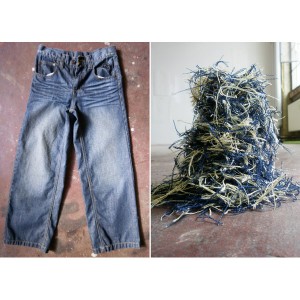 Garment Work, recently on exhibition at the Museum of Contemporary Art in Chicago and Artisterium at the State Silk Museum in Tbilisi Georgia, was originally conducted in residence at the Leipziger Baumwollspinnerei, formerly one of the largest and longest-running textile mills in the world. A site for early radical socialist organizing and a haven of sorts under the GDR, the Baumwollspinnerei took a heavy hit when the Berlin Wall came down, and let most employees go, eventually ceasing production entirely and opening its doors to artists and galleries. Local demand for textiles, however, did not decrease in 1989, nor the products they are made from, and shortly after the Fall of the Wall, the newly reunited Germany took advantage of an international policy called the Multi-Fibre Agreement, which was intended to allow the world’s most impoverished countries the chance to enter the lucrative garment industry. Today, however, this agreement has ended, alongside the local benefits it ensured, so Cambodian women now make t-shirts and jeans for the US and Germany and others under extremely difficult conditions.
Garment Work, recently on exhibition at the Museum of Contemporary Art in Chicago and Artisterium at the State Silk Museum in Tbilisi Georgia, was originally conducted in residence at the Leipziger Baumwollspinnerei, formerly one of the largest and longest-running textile mills in the world. A site for early radical socialist organizing and a haven of sorts under the GDR, the Baumwollspinnerei took a heavy hit when the Berlin Wall came down, and let most employees go, eventually ceasing production entirely and opening its doors to artists and galleries. Local demand for textiles, however, did not decrease in 1989, nor the products they are made from, and shortly after the Fall of the Wall, the newly reunited Germany took advantage of an international policy called the Multi-Fibre Agreement, which was intended to allow the world’s most impoverished countries the chance to enter the lucrative garment industry. Today, however, this agreement has ended, alongside the local benefits it ensured, so Cambodian women now make t-shirts and jeans for the US and Germany and others under extremely difficult conditions.
The Chicago version was a collaborative performance project and ongoing research investigation into the relationship between Cambodian textile manufacturers and Michigan Avenue garment purchasers. The Museum of Contemporary Art, just around the corner from H&M (the world’s second largest clothing manufacturer), frequently acts as a post-shopping stopping point for Michigan Avenue fashionistas. During the run of the exhibition, Moore and museum visitors (and, frequently, staff) took apart a pair of Cambodian-manufactured H&M jeans by hand around a table, collectively dissecting the means by which they were put together, each contributing knowledge about the industry, the offshore workers, or local retail labor conditions. During the month of the exhibition (August, 2011), Cambodian garment workers in H&M factories had been “mysteriously” fainting in mass numbers. The clothing company investigated, and as the exhibition closed announced their findings: H&M was not responsible for the sudden illnesses. By then, however, visitors to the exhibition had learned about the repressive economic and health conditions workers toil under, both in Cambodia and at the corner H&M store, and questioned the reliability of the company’s findings. These discussions, images, and news reports were documented in a series of drawings Moore created daily.
Previous installations have incorporated video, an installation of the constituent elements of a single pair of jeans, and a Tagebuch, kept in German, that references the Baumwollspinnerei’s Brigadebucher, regular diaries of sociopolitical life at the textile mill under the GDR. The Garment Work video distills 34 hours and 36 minutes of work into a ten-hour video of Moore’s original durational performance, which involved taking apart a pair of jeans with her bare hands under the contemporary conditions of the former textile mill over the course of three weeks. The length of the video mimics the contemporary Cambodian garment worker’s workday, inclusive of to ten-minute breaks, a short lunch, and mandatory overtime.Garment Work is a meditation on capitalism, integrity, loss, and perseverance.
The project has been exhibited at the Leipziger Baumwollspinnerei in Germany; Meta House in Phnom Penh, Cambodia; DoVA Temporary, Chicago; and the Museum of Contemporary Art. The video was screened at the 2011 College Art Association conference in New York City. In the fall of 2011, the Garment Work video was be screened at the Artisterium in Tbilisi, Georgia, in a special exhibition underscoring the precariousness of Georgia’s emerging economy at the State Silk Museum alongside Elizabeth White’s Dressing Room. This project was supported in part by a School of the Art Institute of Chicago Faculty Enrichment Grant, a Chances Dances Critical Fierceness Grant, and numerous individuals around the world.
“Garment Work: unpicking the global garment industry” appeared in the March 2012 Journal of Modern Craft.
A ten-minute preview video is available here.
Radio Free Ruin had me on to talk about Garment Work and tell cat jokes.
iART.ge conducted this interview with Elizabeth White and me in the State Silk Museum.
Georgia Today ran this short piece, translated from Georgian I assume.
Read more about the MCA exhibition here (slideshow included).
Check out Moore’s interview with CBS Chicago.
Art Daily ran a short piece on the Chicago exhibition.
A thoughtful review was posted on this fashion blog.
Read an interview on Art21, and the follow-up on Bad At Sports.
Listen to an interview with Moore on Outside the Loop Radio.